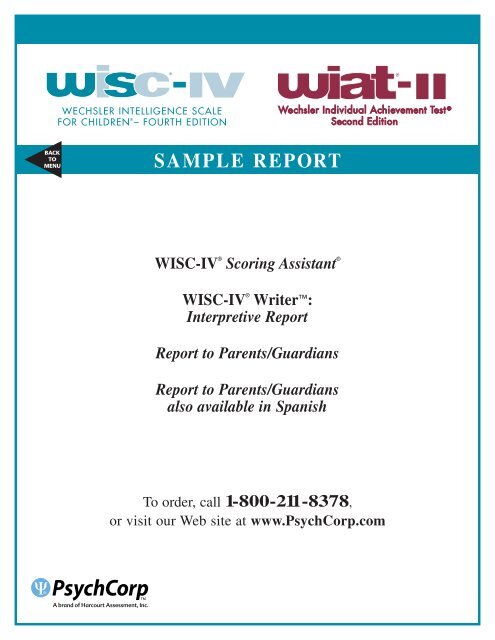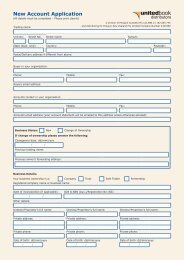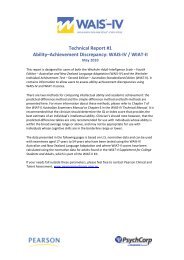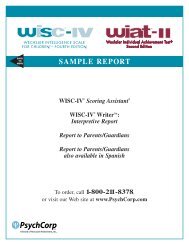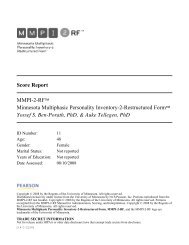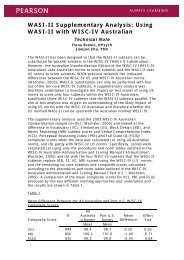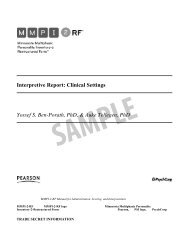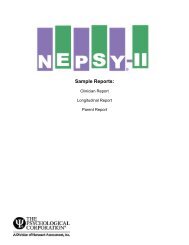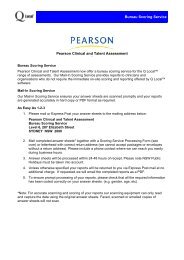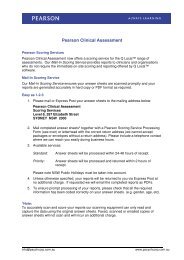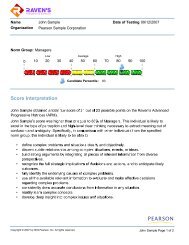WISC-IV with WIAT-II Writer Interpretive Sample Report - Pearson ...
WISC-IV with WIAT-II Writer Interpretive Sample Report - Pearson ...
WISC-IV with WIAT-II Writer Interpretive Sample Report - Pearson ...
You also want an ePaper? Increase the reach of your titles
YUMPU automatically turns print PDFs into web optimized ePapers that Google loves.
BACK<br />
TO<br />
MENU<br />
SAMPLE REPORT<br />
<strong>WISC</strong>-<strong>IV</strong> ®<br />
Scoring Assistant ®<br />
<strong>WISC</strong>-<strong>IV</strong> ®<br />
<strong>Writer</strong>: <strong>Interpretive</strong> <strong>Report</strong><br />
<strong>Report</strong> to Parents/Guardians<br />
<strong>Report</strong> to Parents/Guardians<br />
also available in Spanish<br />
To order, call 1-800-211-8378,<br />
or visit our Web site at www.PsychCorp.com
BACK<br />
TO<br />
MENU<br />
This sample shows the integration of <strong>WISC</strong>-<strong>IV</strong> and <strong>WIAT</strong>-<strong>II</strong> for customers <strong>with</strong> the <strong>WIAT</strong>-<strong>II</strong><br />
Scoring Assistant.<br />
Please contact Customer Service if you would like to order the <strong>WIAT</strong>-<strong>II</strong> Scoring Assistant.<br />
Copyright © 2003 by Harcourt Assessment, Inc.<br />
All rights reserved. Printed in the United States of America.
BACK<br />
TO<br />
MENU<br />
Tables and Graphs <strong>Report</strong> for <strong>WISC</strong>-<strong>IV</strong> and <strong>WIAT</strong>-<strong>II</strong><br />
EXAMINEE: Haley Keller REPORT DATE: 6/6/2003<br />
AGE: 11 years 3 months GRADE: 5 th<br />
DATE OF BIRTH: 2/18/1992 ETHNICITY: African/African American<br />
EXAMINEE ID: 6021 EXAMINER: Emily Martinez<br />
GENDER: Female<br />
Tests Administered: <strong>WISC</strong>-<strong>IV</strong> (6/12/03)<br />
<strong>WIAT</strong>-<strong>II</strong> (6/12/03)<br />
Is this a retest? No<br />
Comments:<br />
Composite Scores Summary<br />
Sum of<br />
Scaled<br />
Copyright © 2003 by Harcourt Assessment, Inc.<br />
All rights reserved. Printed in the United States of America.<br />
Page 1<br />
Age at Testing: <strong>WISC</strong>-<strong>IV</strong> (11 years 3 months)<br />
<strong>WIAT</strong>-<strong>II</strong> (11 years 3 months)<br />
95%<br />
Confidence<br />
Composite Percentile<br />
Qualitative<br />
Scale<br />
Scores Score Rank Interval<br />
Description<br />
Verbal Comprehension (VCI) 37 112 79 105-118 High Average<br />
Perceptual Reasoning (PRI) 26 92 30 85-100 Average<br />
Working Memory (WMI) 21 102 55 94-109 Average<br />
Processing Speed (PSI) 17 91 27 83-101 Average<br />
Full Scale (FSIQ) 101 101 53 96-106 Average
BACK<br />
TO<br />
MENU<br />
Tables and Graphs <strong>Report</strong> for <strong>WISC</strong>-<strong>IV</strong> and <strong>WIAT</strong>-<strong>II</strong><br />
Vertical bar represents the Standard Error of Measurement.<br />
Composite Score SEM Composite Score SEM<br />
VCI 112 3.97 PSI 91 4.74<br />
PRI 92 3.97 FSIQ 101 2.6<br />
WMI 102 4.24<br />
Copyright © 2003 by Harcourt Assessment, Inc.<br />
All rights reserved. Printed in the United States of America.<br />
Page 2
BACK<br />
TO<br />
MENU<br />
Tables and Graphs <strong>Report</strong> for <strong>WISC</strong>-<strong>IV</strong> and <strong>WIAT</strong>-<strong>II</strong><br />
Verbal Comprehension Subtest Scores Summary<br />
Raw Scaled Test Age Percentile<br />
Subtests<br />
Score Score Equiv. Rank<br />
Similarities 26 12 13:10 75<br />
Vocabulary 44 13 14:10 84<br />
Comprehension 28 12 14:6 75<br />
Perceptual Reasoning Subtest Scores Summary<br />
Raw Scaled Test Age Percentile<br />
Subtests<br />
Score Score Equiv. Rank<br />
Block Design 32 9 10:6 37<br />
Picture Concepts 16 8 8:10 25<br />
Matrix Reasoning 20 9 9:10 37<br />
Working Memory Subtest Scores Summary<br />
Raw Scaled Test Age Percentile<br />
Subtests<br />
Score Score Equiv. Rank<br />
Digit Span 16 10 10:10 50<br />
Letter-Number Sequencing 18 11 13:2 63<br />
(Arithmetic) 23 10 10:10 50<br />
Processing Speed Subtest Scores Summary<br />
Raw Scaled Test Age Percentile<br />
Subtests<br />
Score Score Equiv. Rank<br />
Coding 45 9 10:6 37<br />
Symbol Search 21 8 9:10 25<br />
(Cancellation) 73 9 10:2 37<br />
Copyright © 2003 by Harcourt Assessment, Inc.<br />
All rights reserved. Printed in the United States of America.<br />
Page 3
BACK<br />
TO<br />
MENU<br />
Tables and Graphs <strong>Report</strong> for <strong>WISC</strong>-<strong>IV</strong> and <strong>WIAT</strong>-<strong>II</strong><br />
Vertical bar represents the Standard Error of Measurement.<br />
Subtest Score SEM Subtest Score SEM<br />
Similarities (SI) 12 1.24 Picture Completion (PCm)<br />
Vocabulary (VC) 13 1.08 Digit Span (DS) 10 1.12<br />
Comprehension (CO) 12 1.31 Letter-Number Sequencing (LN) 11 0.9<br />
Information (IN) Arithmetic (AR) 10 1.2<br />
Word Reasoning (WR) Coding (CD) 9 0.99<br />
Block Design (BD) 9 1.08 Symbol Search (SS) 8 1.34<br />
Picture Concepts (PCn) 8 1.24 Cancellation (CA) 9 1.2<br />
Matrix Reasoning (MR) 9 0.99<br />
Copyright © 2003 by Harcourt Assessment, Inc.<br />
All rights reserved. Printed in the United States of America.<br />
Page 4
BACK<br />
TO<br />
MENU<br />
Tables and Graphs <strong>Report</strong> for <strong>WISC</strong>-<strong>IV</strong> and <strong>WIAT</strong>-<strong>II</strong><br />
Composite Score Differences<br />
Scaled Scaled<br />
Critical<br />
Sig.<br />
Diff. Base<br />
Discrepancy Comparisons<br />
Score 1 Score 2 Diff. Value Y/N Rate<br />
VCI - PRI 112 92 20 11 Y 6.1%<br />
VCI - WMI 112 102 10 11.38 N 22.9%<br />
VCI - PSI 112 91 21 12.12 Y 9.7%<br />
PRI - WMI 92 102 -10 11.38 N 24.5%<br />
PRI - PSI 92 91 1 12.12 N 49.3%<br />
WMI - PSI<br />
Base Rate by Overall <strong>Sample</strong><br />
102 91 11 12.46 N 24.1%<br />
Statistical Significance (Critical Values) at the .05 level<br />
Subtest Score Differences<br />
Scaled Scaled<br />
Critical<br />
Sig.<br />
Diff. Base<br />
Discrepancy Comparisons<br />
Score 1 Score 2 Diff. Value Y/N Rate<br />
Digit Span - Letter-Number Sequencing 10 11 -1 2.83 N 47.1%<br />
Coding - Symbol Search 9 8 1 3.55 N 40.2%<br />
Similarities - Picture Concepts 12 8 4 3.36 Y 13.0%<br />
Digit Span - Arithmetic 10 10 0 2.94 N<br />
Letter-Number Sequencing - Arithmetic 11 10 1 2.80 N 44.4%<br />
Coding - Cancellation 9 9 0 3.58 N<br />
Symbol Search - Cancellation 8 9 -1 3.80 N 43.0%<br />
Statistical Significance (Critical Values) at the .05 level<br />
Differences between Subtest and Mean of Subtest Scores<br />
Subtest<br />
Scaled<br />
Mean<br />
Scaled<br />
Diff.<br />
from<br />
Critical<br />
Base<br />
Subtest<br />
Score Score Mean Value S/W Rate<br />
Block Design 9 8.67 0.33 2.22 >25%<br />
Similarities 12 12.33 -0.33 2.23 >25%<br />
Picture Concepts 8 8.67 -0.67 2.38 >25%<br />
Vocabulary 13 12.33 0.67 2.11 >25%<br />
Matrix Reasoning 9 8.67 0.33 2.09 >25%<br />
Comprehension 12 12.33 -0.33 2.41 >25%<br />
Verbal Comprehension: Mean = 12.33, Scatter = 1, Base Rate = 96.4%<br />
Perceptual Reasoning: Mean = 8.67, Scatter = 1, Base Rate = 98.2%<br />
Statistical Significance (Critical Values) at the .05 level<br />
Copyright © 2003 by Harcourt Assessment, Inc.<br />
All rights reserved. Printed in the United States of America.<br />
Page 5
BACK<br />
TO<br />
MENU<br />
Tables and Graphs <strong>Report</strong> for <strong>WISC</strong>-<strong>IV</strong> and <strong>WIAT</strong>-<strong>II</strong><br />
Process Summary and Discrepancy Analysis<br />
Process Score Raw Score Scaled Score<br />
Block Design No Time Bonus 32 9<br />
Digit Span Forward 9 11<br />
Digit Span Backward 7 10<br />
Cancellation Random 32 8<br />
Cancellation Structured 41 10<br />
Process Score Raw Score Base Rate<br />
Longest Digit Span Forward (LDSF) 6 63%<br />
Longest Digit Span Backward (LDSB) 4 72%<br />
Process Discrepancy Comparisons<br />
Process Score Raw Score 1 Raw Score 2 Difference Base Rate<br />
LDSF - LDSB 6 4 2 62.4%<br />
Base Rate by All Ages<br />
Scaled Scaled<br />
Critical<br />
Sig.<br />
Diff. Base<br />
Subtest/Process Score<br />
Score 1 Score 2 Diff. Value Y/N Rate<br />
Block Design - Block Design No Time Bonus 9 9 0.00 3.26 N<br />
Digit Span Forward - Digit Span Backward 11 10 1.00 3.62 N 44.2%<br />
Cancellation Random - Structured 8 10 -2.00 4.40 N 24.6%<br />
Statistical Significance (Critical Values) at the .05 level<br />
Copyright © 2003 by Harcourt Assessment, Inc.<br />
All rights reserved. Printed in the United States of America.<br />
Page 6
BACK<br />
TO<br />
MENU<br />
Tables and Graphs <strong>Report</strong> for <strong>WISC</strong>-<strong>IV</strong> and <strong>WIAT</strong>-<strong>II</strong><br />
<strong>WISC</strong>-<strong>IV</strong> Total Raw Scores<br />
Subtest Score Range Raw Score<br />
Block Design 0 to 68 32<br />
Similarities 0 to 44 26<br />
Digit Span 0 to 32 16<br />
Picture Concepts 0 to 28 16<br />
Coding 0 to 119 45<br />
Vocabulary 0 to 68 44<br />
Letter-Number Sequencing 0 to 30 18<br />
Matrix Reasoning 0 to 35 20<br />
Comprehension 0 to 42 28<br />
Symbol Search 0 to 60 21<br />
Picture Completion 0 to 38<br />
Cancellation 0 to 136 73<br />
Information 0 to 33<br />
Arithmetic 0 to 34 23<br />
Word Reasoning 0 to 24<br />
Process Score Score Range Raw Score<br />
Block Design No Time Bonus 0 to 50 32<br />
Digit Span Forward 0 to 16 9<br />
Digit Span Backward 0 to 16 7<br />
Cancellation Random 0 to 68 32<br />
Cancellation Structured 0 to 68 41<br />
Longest Digit Span Forward 0,2 to 9 6<br />
Longest Digit Span Backward 0,2 to 8 4<br />
Copyright © 2003 by Harcourt Assessment, Inc.<br />
All rights reserved. Printed in the United States of America.<br />
Page 7
BACK<br />
TO<br />
MENU<br />
Summary of <strong>WIAT</strong>-<strong>II</strong> Subtest Scores<br />
Tables and Graphs <strong>Report</strong> for <strong>WISC</strong>-<strong>IV</strong> and <strong>WIAT</strong>-<strong>II</strong><br />
95%<br />
AGE GRADE<br />
SUBTESTS* RAW STD INTERVAL PR NCE S9 EQU EQU<br />
Word Reading 79 72 67- 77 3 11 1 7:8 2:6<br />
Reading Comprehension 108** 83 76- 90 13 26 3 8:8 3:2<br />
Pseudoword Decoding 12 75 70- 80 5 15 2 6:4 1:7<br />
Numerical Operations 28 103 94- 112 58 54 5 11:4 5:8<br />
Math Reasoning 40 91 83- 99 27 37 4 10:0 4:8<br />
Spelling 27 88 82- 94 21 33 3 9:4 3:8<br />
Written Expression 12 78 65- 91 7 19 2 8:0 3:0<br />
Listening Comprehension 22 84 70- 98 14 28 3 8:4 3:2<br />
Oral Expression 20 83 71- 95 13 26 3 7:8 3:0<br />
* <strong>WIAT</strong>-<strong>II</strong> age-based normative information was used in the calculation of subtest and composite scores.<br />
** Represents Reading Comprehension weighted raw score.<br />
Summary of <strong>WIAT</strong>-<strong>II</strong> Composite and Total Scores<br />
COMPOSITES* RAW STD<br />
95%<br />
INTERVAL PR NCE S9<br />
Reading 230 75 71- 79 5 15 2<br />
Mathematics 194 96 89- 103 39 44 4<br />
Written Language 166 82 74- 90 12 25 3<br />
Oral Language 167 81 70- 92 10 23 2<br />
Total 757 80 76- 84 9 22 2<br />
* <strong>WIAT</strong>-<strong>II</strong> age-based normative information was used in the calculation of subtest and composite scores<br />
Copyright © 2003 by Harcourt Assessment, Inc.<br />
All rights reserved. Printed in the United States of America.<br />
Page 8
BACK<br />
TO<br />
MENU<br />
Tables and Graphs <strong>Report</strong> for <strong>WISC</strong>-<strong>IV</strong> and <strong>WIAT</strong>-<strong>II</strong><br />
Differences Between Subtest Scores and Mean of Subtest Scores<br />
STD DIFF.<br />
SUBTESTS<br />
SCORE FROM MEAN SIGNIF. FREQ S/W<br />
Word Reading 72 -12.11 .05* 25% W<br />
Reading Comprehension 83 -1.11 ns >25%<br />
Pseudoword Decoding 75 -9.11 .05* >25% W<br />
Numerical Operations 103 18.89 .05* 10% S<br />
Math Reasoning 91 6.89 ns >25%<br />
Spelling 88 3.89 ns >25%<br />
Written Expression 78 -6.11 ns >25%<br />
Listening Comprehension 84 -0.11 ns >25%<br />
Oral Expression 83 -1.11 ns >25%<br />
Mean of Subtest Standard Scores = 84.11<br />
* significant at the .05 level<br />
Differences Between Composite Standard Scores<br />
COMPOSITES DIFFERENCE SIGNIF. FREQUENCY<br />
Reading/Mathematics -21 .05* 7%<br />
Reading/Oral Language -6 ns 34.9%<br />
Reading/Written Language -7 .15 30.3%<br />
Mathematics/Oral Language 15 .05* 14.9%<br />
Mathematics/Written Language 14 .05* 14.4%<br />
Oral Language/Written Language -1 ns 49.2%<br />
* significant at the .05 level<br />
Copyright © 2003 by Harcourt Assessment, Inc.<br />
All rights reserved. Printed in the United States of America.<br />
Page 9
BACK<br />
TO<br />
MENU<br />
Tables and Graphs <strong>Report</strong> for <strong>WISC</strong>-<strong>IV</strong> and <strong>WIAT</strong>-<strong>II</strong><br />
Subtest SS SEM Subtest SS SEM<br />
Word Reading (WR) 72 2 Spelling (SP) 88 3<br />
Reading Comprehension (RC) 83 3 Written Expression (WE) 78 6<br />
Pseudoword Decoding (PD) 75 2 Listening Comprehension (LC) 84 7<br />
Numerical Operations (NO) 103 4 Oral Expression (OE) 83 6<br />
Math Reasoning (MR) 91 3<br />
Copyright © 2003 by Harcourt Assessment, Inc.<br />
All rights reserved. Printed in the United States of America.<br />
Page 10
BACK<br />
TO<br />
MENU<br />
Tables and Graphs <strong>Report</strong> for <strong>WISC</strong>-<strong>IV</strong> and <strong>WIAT</strong>-<strong>II</strong><br />
Ability-Achievement Discrepancy Analysis<br />
Date of Ability Testing: 6/12/03<br />
Ability Score Type: FSIQ<br />
Ability Score: 101<br />
Predicted-Difference Method<br />
Predicted<br />
Score<br />
Actual<br />
Score<br />
Expected<br />
Diff.<br />
Copyright © 2003 by Harcourt Assessment, Inc.<br />
All rights reserved. Printed in the United States of America.<br />
Page 11<br />
Critical<br />
Value<br />
<strong>WIAT</strong>-<strong>II</strong> SUBTEST<br />
Word Reading 101 72 29 4.78 Y
BACK<br />
TO<br />
MENU<br />
<strong>WISC</strong>-<strong>IV</strong> and <strong>WIAT</strong>-<strong>II</strong> <strong>Interpretive</strong> <strong>Report</strong><br />
EXAMINEE: Haley Keller REPORT DATE: 12/4/03<br />
AGE: 11 years 9 months GRADE: Not Specified<br />
DATE OF BIRTH: 2/18/92 ETHNICITY: <br />
EXAMINEE ID: Not Specified EXAMINER: Emily Martinez<br />
GENDER: Female<br />
Tests Administered: <strong>WISC</strong>-<strong>IV</strong> (6/12/03)<br />
<strong>WIAT</strong>-<strong>II</strong> (6/12/03)<br />
Is this a retest? No<br />
SCORES SUMMARY<br />
<strong>WISC</strong>-<strong>IV</strong><br />
COMPOSITE SCORE<br />
Copyright © 2003 by Harcourt Assessment, Inc.<br />
All rights reserved. Printed in the United States of America.<br />
Page 1<br />
Age at Testing: <strong>WISC</strong>-<strong>IV</strong> (11 years 3 months)<br />
<strong>WIAT</strong>-<strong>II</strong> (11 years 3 months)<br />
<strong>WIAT</strong>-<strong>II</strong><br />
COMPOSITE SCORE<br />
Verbal Comprehension Index (VCI) 112 Reading 75<br />
Perceptual Reasoning Index (PRI) 92 Mathematics 96<br />
Working Memory Index (WMI) 102 Written Language 82<br />
Processing Speed Index (PSI) 91 Oral Language 81<br />
Full Scale IQ (FSIQ) 101<br />
Reason for Referral<br />
Referral information for Haley is unknown at this time.<br />
Home<br />
There is no data available regarding Haley’s parent(s), guardian(s), living arrangements, or<br />
family stressors.<br />
Language<br />
There is no data available regarding Haley's language.<br />
Development<br />
There is no data available regarding Haley's pregnancy, birth and developmental history.<br />
Health<br />
There is no information available regarding Haley's sensory/motor status. There is no<br />
information or behavioral observations available regarding Haley’s medical, psychiatric, and<br />
neurological status. There is no data available regarding Haley's use of medication and<br />
substances.<br />
School<br />
There is no information provided regarding Haley's early educational history. Haley's school<br />
performance <strong>with</strong> regard to her attendance, conduct, and academics are unknown at this time.<br />
Haley's past and recent performance on standardized achievement tests is unknown at this time.<br />
Behavior Observation<br />
There are no additional behavioral observations regarding Haley's appearance, affect, test-taking<br />
attitude and behavior.
BACK<br />
TO<br />
MENU<br />
Interpretation of <strong>WISC</strong>-<strong>IV</strong> Results<br />
<strong>WISC</strong>-<strong>IV</strong> and <strong>WIAT</strong>-<strong>II</strong> <strong>Interpretive</strong> <strong>Report</strong><br />
Haley's unique set of thinking and reasoning abilities make her overall intellectual functioning<br />
difficult to summarize by a single score on the Wechsler Intelligence Scale for Children – Fourth<br />
Edition (<strong>WISC</strong>-<strong>IV</strong>). Her verbal reasoning abilities are much better developed than her nonverbal<br />
reasoning abilities. Making sense of complex verbal information and using verbal abilities to<br />
solve novel problems are a strength for Haley. Processing complex visual information by<br />
forming spatial images of part-whole relationships and/or by manipulating the parts to solve<br />
novel problems <strong>with</strong>out using words is a less well-developed ability.<br />
Haley’s verbal reasoning abilities as measured by the Verbal Comprehension Index are in the<br />
High Average range and above those of approximately 79% of her peers (VCI = 112; 95%<br />
confidence interval = 105-118). The Verbal Comprehension Index is designed to measure verbal<br />
reasoning and concept formation. Haley performed comparably on the verbal subtests<br />
contributing to the VCI, suggesting that these verbal cognitive abilities are similarly developed.<br />
Haley’s nonverbal reasoning abilities as measured by the Perceptual Reasoning Index are in the<br />
Average range and above those of approximately 30% of her peers (PRI = 92; 95% confidence<br />
interval = 85-100). The Perceptual Reasoning Index is designed to measure fluid reasoning in<br />
the perceptual domain <strong>with</strong> tasks that assess nonverbal concept formation, visual perception and<br />
organization, simultaneous processing, visual-motor coordination, learning, and the ability to<br />
separate figure and ground in visual stimuli. Haley performed comparably on the perceptual<br />
reasoning subtests contributing to the PRI, suggesting that her visual-spatial reasoning and<br />
perceptual-organizational skills are similarly developed. Haley performed much better on<br />
abstract concept formation and categorical reasoning tasks that did not require verbal expression<br />
(Similarities = 12) than on abstract concept formation and categorical reasoning tasks that<br />
required verbal expression (Picture Concepts= 8).<br />
Haley's ability to sustain attention, concentrate, and exert mental control is in the Average range.<br />
She performed better than approximately 55% of her age-mates in this area (Working Memory<br />
Index = 102; 95% confidence interval 94-109).<br />
Haley's ability in processing simple or routine visual material <strong>with</strong>out making errors is in the<br />
Average range when compared to her peers. She performed better than approximately 27% of<br />
her peers on the processing speed tasks (Processing Speed Index = 91; 95% confidence interval<br />
83-101). Processing visual material quickly is an ability that Haley performs less well than her<br />
verbal reasoning ability. Processing speed is an indication of the rapidity <strong>with</strong> which Haley can<br />
mentally process simple or routine information <strong>with</strong>out making errors. Because learning often<br />
involves a combination of routine information processing (such as reading) and complex<br />
information processing (such as reasoning), a relative weakness in the speed of processing<br />
routine information may make the task of comprehending novel information more timeconsuming<br />
and difficult for Haley. Thus, this relative weakness in simple visual scanning and<br />
tracking may leave her less time and mental energy for the complex task of understanding new<br />
material. The noticed by Haley's referral source may be related to this weakness in processing<br />
speed. Although much less developed than her verbal and nonverbal reasoning abilities Haley's<br />
speed of information processing abilities are still <strong>with</strong>in the Average range and better than those<br />
Copyright © 2003 by Harcourt Assessment, Inc.<br />
All rights reserved. Printed in the United States of America.<br />
Page 2
BACK<br />
TO<br />
MENU<br />
<strong>WISC</strong>-<strong>IV</strong> and <strong>WIAT</strong>-<strong>II</strong> <strong>Interpretive</strong> <strong>Report</strong><br />
of approximately 27% of her age-mates (Processing Speed Index = 91; 95% confidence interval<br />
85-100).<br />
Personal Strengths and Weakness<br />
Haley achieved her best performance among the verbal reasoning tasks on the Vocabulary<br />
subtest. Her strong performance on the Vocabulary subtest was better than that of most students<br />
her age. The Vocabulary subtest required Haley to explain the meaning of words presented in<br />
isolation. As a direct assessment of word knowledge, the subtest is one indication of her overall<br />
verbal comprehension. Performance on this subtest also requires abilities to verbalize<br />
meaningful concepts as well as to retrieve information from long-term memory; (Vocabulary<br />
scaled score = 13).<br />
Interpretation of <strong>WIAT</strong>-<strong>II</strong> Results<br />
Reading<br />
Haley presents a diverse set of skills on different aspects of reading. She performed much better<br />
on tasks that assessed her capability to read sentences and paragraphs and answer questions<br />
about what was read (Reading Comprehension standard score = 83) than on tasks that required<br />
her to correctly read a series of printed words (Word Reading standard score = 72). A relative<br />
strength in comprehension skills as compared to reading words in isolation may indicate that<br />
Haley is able to derive meaning from text using context clues but may not have learned<br />
vocabulary words to automaticity. For this reason, the Reading Composite score may not be the<br />
most accurate manner in which to summarize her reading skills. Her Reading Comprehension<br />
subtest score is higher than only approximately 13% of her peers, placing these skills in the Low<br />
Average range. Haley’s performance on Word Reading is <strong>with</strong>in the Borderline range and<br />
exceeds that of approximately 3% of students her age.<br />
Mathematics<br />
In overall mathematics skills Haley performed in the Average range, as indicated by her<br />
Mathematics Composite standard score (96). However, her skills in this area exceed that of only<br />
approximately 39% of students her age. Haley's performance on tasks that required her to add,<br />
subtract, multiple, and divide one- to three-digit numbers (Numerical Operations standard score<br />
= 103) is comparable to her performance on tasks that requires her to understand number,<br />
consumer math concepts, geometric measurement, basic graphs, and solve one-step word<br />
problems (Math Reasoning standard score = 91).<br />
Oral Language<br />
Haley performed in the Low Average range in overall language skills, as indicated by her<br />
standard score on the Oral Language Composite (81). Her skills in this area exceed those of<br />
only approximately 10% of students her age. Haley performed comparably on tasks that<br />
required her to identify the picture that best represents an orally presented descriptor or generate<br />
a word that matches the picture (Listening Comprehension standard score = 84) and generate<br />
words <strong>with</strong>in a category, describe scenes, and give directions (Oral Expression standard score =<br />
83).<br />
Copyright © 2003 by Harcourt Assessment, Inc.<br />
All rights reserved. Printed in the United States of America.<br />
Page 3
BACK<br />
TO<br />
MENU<br />
<strong>WISC</strong>-<strong>IV</strong> and <strong>WIAT</strong>-<strong>II</strong> <strong>Interpretive</strong> <strong>Report</strong><br />
Written Language<br />
In overall written language skills, Haley performed in the Low Average range, as indicated by<br />
her Written Language Composite standard score (82). Her achievement in this area is better<br />
than of only approximately 12% of students her age. Haley's performance on tasks that required<br />
her to generate words <strong>with</strong>in a category, generate sentences to describe visual cues, combine<br />
sentences, and compose an organized paragraph (Written Expression standard score = 78) is<br />
comparable to her performance on tasks that required her to correctly spell verbally presented<br />
words (Spelling standard score = 88).<br />
Strengths And Weaknesses<br />
Compared to Haley's mean score for all <strong>WIAT</strong>-<strong>II</strong> subtests, her performance is significantly better<br />
in Numerical Operations, indicating that this is an area of relative strength for her. Compared to<br />
those of other children her age, however, her skills in this area are in the Average range.<br />
Word Reading and Pseudoword Decoding are notable weaknesses for Haley. Her scores on<br />
these subtests are significantly less than her mean score for all <strong>WIAT</strong>-<strong>II</strong> subtests, indicating that<br />
these are areas of lower performance relative to her other skills. She performed better than only<br />
approximately 3% and 5% of her peers on Word Reading and Pseudoword Decoding,<br />
respectively. Thus, Haley may experience great difficulty keeping up <strong>with</strong> other students when<br />
these skills are needed.<br />
Ability-Achievement Discrepancy Analysis Predicted Method<br />
Haley's scores on the <strong>WIAT</strong>-<strong>II</strong> were compared to the levels of achievement predicted for a<br />
student <strong>with</strong> her general cognitive ability, as indicated by her Verbal Comprehension score of<br />
112 on the <strong>WISC</strong>-<strong>IV</strong> administered 6/12/2003. Significant differences between actual and<br />
predicted achievement scores are reported in this section.<br />
Haley displays difficulty <strong>with</strong> achievement in reading. She scored much lower on the Reading<br />
Composite (actual score = 75) than expected for a child <strong>with</strong> her general cognitive ability<br />
(predicted score = 109). The difference between her actual and predicted scores is significant and<br />
highly unusual. Thus, this is an area in which Haley may benefit from assistance in helping her<br />
further develop her skills. Word Reading (actual standard score = 72), Pseudoword Decoding<br />
(actual standard score = 75) and Reading Comprehension (actual standard score = 83) are areas<br />
of difficulty for Haley. The difference between Haley's actual and predicted scores on the Word<br />
Reading subtest (37 points) is both significant and highly unusual, and indicates a specific<br />
weakness in tasks that required her to correctly read a series of printed words. For the<br />
Pseudoword Decoding and Reading Comprehension subtests, the discrepancy between her actual<br />
and predicted scores(32 points) and(26 points) is also significant, suggesting a specific weakness<br />
in tasks that required Haley to correctly apply phonetic decoding rules when reading a series of<br />
nonsense words and read sentences and paragraphs and answer questions about what was read.<br />
Specifically, there is a noteworthy difference between her Math Reasoning subtest score (91) and<br />
the level of achievement anticipated for a student <strong>with</strong> her cognitive ability (predicted score =<br />
108). This significant and highly unusual difference indicates performance lower than expected<br />
Copyright © 2003 by Harcourt Assessment, Inc.<br />
All rights reserved. Printed in the United States of America.<br />
Page 4
BACK<br />
TO<br />
MENU<br />
<strong>WISC</strong>-<strong>IV</strong> and <strong>WIAT</strong>-<strong>II</strong> <strong>Interpretive</strong> <strong>Report</strong><br />
on tasks that required her to understand number, consumer math concepts, geometric<br />
measurement, basic graphs, and solve one-step word problems. Although lower than expected,<br />
Haley's performance in this area is still in the Average range.<br />
Haley displays difficulty <strong>with</strong> achievement in oral language. She scored much lower on the Oral<br />
Language Composite (actual score = 81) than expected for a child <strong>with</strong> her general cognitive<br />
ability (predicted score = 109). The difference between her actual and predicted scores is<br />
significant and highly unusual. Thus, this is an area in which Haley may benefit from assistance<br />
in helping her further develop her skills. Both Oral Expression (actual standard score = 83) and<br />
Listening Comprehension (actual standard score = 84) are areas of difficulty for Haley. The<br />
difference between Haley's actual and predicted scores on the Oral Expression subtest (23 points)<br />
is both significant and highly unusual, and indicates a specific weakness in tasks that required<br />
her to generate words <strong>with</strong>in a category, describe scenes, and give directions. For the Listening<br />
Comprehension subtests, the discrepancy between her actual and predicted scores (25 points) is<br />
also significant, suggesting a specific weakness in tasks that required Haley to identify the<br />
picture that best represents an orally presented descriptor or generate a word that matches the<br />
picture.<br />
Haley displays difficulty <strong>with</strong> achievement in written language skills. She scored much lower on<br />
the Written Language Composite (actual score = 82) than expected for a child <strong>with</strong> her general<br />
cognitive ability (predicted score = 108). The difference between her actual and predicted scores<br />
is significant and highly unusual. Thus, this is an area in which Haley may benefit from<br />
assistance in helping her further develop her skills. Both Written Expression (actual standard<br />
score = 78) and Spelling (actual standard score = 88) are areas of difficulty for Haley. The<br />
difference between Haley's actual and predicted scores on the Written Expression subtest (29<br />
points) is both significant and highly unusual, and indicates a specific weakness in tasks that<br />
required her to generate words <strong>with</strong>in a category, generate sentences to describe visual cues,<br />
combine sentences, and compose an organized paragraph. For the Spelling subtests, the<br />
discrepancy between her actual and predicted scores (20 points) is also significant, suggesting a<br />
specific weakness in tasks that required Haley to correctly spell verbally presented words.<br />
Haley's weakness in Oral Expression combined <strong>with</strong> her much better performance on the <strong>WISC</strong>-<br />
<strong>IV</strong> verbal subtests (VCI = High Average range) indicates that while functional use of language<br />
may be difficult for her, she can answer challenging verbal reasoning problems very well when<br />
not unduly penalized for ineloquence of expression.<br />
Summary<br />
Haley is an 11-year-old child who completed the <strong>WISC</strong>-<strong>IV</strong> and the <strong>WIAT</strong>-<strong>II</strong>. Her overall<br />
cognitive ability, as evaluated by the <strong>WISC</strong>-<strong>IV</strong>, cannot easily be summarized because her verbal<br />
reasoning abilities are much better developed than her nonverbal reasoning abilities. Haley's<br />
reasoning abilities on verbal tasks are generally in the High Average range (VCI = 112), while<br />
her nonverbal reasoning abilities are significantly lower and in the Average range (PRI = 92).<br />
She demonstrated relatively weak skills in Listening Comprehension, Math Reasoning, Oral<br />
Expression, Pseudoword Decoding, Reading Comprehension, Spelling, Word Reading, and<br />
Copyright © 2003 by Harcourt Assessment, Inc.<br />
All rights reserved. Printed in the United States of America.<br />
Page 5
BACK<br />
TO<br />
MENU<br />
<strong>WISC</strong>-<strong>IV</strong> and <strong>WIAT</strong>-<strong>II</strong> <strong>Interpretive</strong> <strong>Report</strong><br />
Written Expression on the <strong>WIAT</strong>-<strong>II</strong>. Her skills in Math Reasoning are still <strong>with</strong>in the range<br />
expected for her age.<br />
Composite Scores Summary<br />
Sum of<br />
Scaled Composite Percentile Confidence Qualitative<br />
Scale<br />
Scores Score Rank Interval<br />
Description<br />
Verbal Comprehension (VCI) 37 112 79 105-118 High Average<br />
Perceptual Reasoning (PRI) 26 92 30 85-100 Average<br />
Working Memory (WMI) 21 102 55 94-109 Average<br />
Processing Speed (PSI) 17 91 27 83-101 Average<br />
Full Scale (FSIQ) 101 101 53 96-106 Average<br />
Copyright © 2003 by Harcourt Assessment, Inc.<br />
All rights reserved. Printed in the United States of America.<br />
Page 6
BACK<br />
TO<br />
MENU<br />
<strong>WISC</strong>-<strong>IV</strong> and <strong>WIAT</strong>-<strong>II</strong> <strong>Interpretive</strong> <strong>Report</strong><br />
Vertical bar represents the Standard Error of Measurement.<br />
Composite Score SEM Composite Score SEM<br />
VCI 112 3.97 PSI 91 4.74<br />
PRI 92 3.97 FSIQ 101 2.6<br />
WMI 102 4.24<br />
Copyright © 2003 by Harcourt Assessment, Inc.<br />
All rights reserved. Printed in the United States of America.<br />
Page 7
BACK<br />
TO<br />
MENU<br />
<strong>WISC</strong>-<strong>IV</strong> and <strong>WIAT</strong>-<strong>II</strong> <strong>Interpretive</strong> <strong>Report</strong><br />
Verbal Comprehension Subtest Scores Summary<br />
Raw Scaled Test Age Percentile<br />
Subtests<br />
Score Score Equiv. Rank<br />
Similarities 26 12 13:10 75<br />
Vocabulary 44 13 14:10 84<br />
Comprehension 28 12 14:6 75<br />
Perceptual Reasoning Subtest Scores Summary<br />
Raw Scaled Test Age Percentile<br />
Subtests<br />
Score Score Equiv. Rank<br />
Block Design 32 9 10:6 37<br />
Picture Concepts 16 8 8:10 25<br />
Matrix Reasoning 20 9 9:10 37<br />
Working Memory Subtest Scores Summary<br />
Raw Scaled Test Age Percentile<br />
Subtests<br />
Score Score Equiv. Rank<br />
Digit Span 16 10 10:10 50<br />
Letter-Number Sequencing 18 11 13:2 63<br />
(Arithmetic) 23 10 10:10 50<br />
Processing Speed Subtest Scores Summary<br />
Raw Scaled Test Age Percentile<br />
Subtests<br />
Score Score Equiv. Rank<br />
Coding 45 9 10:6 37<br />
Symbol Search 21 8 9:10 25<br />
(Cancellation) 73 9 10:2 37<br />
Copyright © 2003 by Harcourt Assessment, Inc.<br />
All rights reserved. Printed in the United States of America.<br />
Page 8
BACK<br />
TO<br />
MENU<br />
<strong>WISC</strong>-<strong>IV</strong> and <strong>WIAT</strong>-<strong>II</strong> <strong>Interpretive</strong> <strong>Report</strong><br />
Vertical bar represents the Standard Error of Measurement.<br />
Subtest Score SEM Subtest Score SEM<br />
Similarities (SI) 12 1.24 Picture Completion (PCm)<br />
Vocabulary (VC) 13 1.08 Digit Span (DS) 10 1.12<br />
Comprehension (CO) 12 1.31 Letter-Number Sequencing (LN) 11 0.9<br />
Information (IN) Arithmetic (AR) 10 1.2<br />
Word Reasoning (WR) Coding (CD) 9 0.99<br />
Block Design (BD) 9 1.08 Symbol Search (SS) 8 1.34<br />
Picture Concepts (PCn) 8 1.24 Cancellation (CA) 9 1.2<br />
Matrix Reasoning (MR) 9 0.99<br />
Copyright © 2003 by Harcourt Assessment, Inc.<br />
All rights reserved. Printed in the United States of America.<br />
Page 9
BACK<br />
TO<br />
MENU<br />
<strong>WISC</strong>-<strong>IV</strong> and <strong>WIAT</strong>-<strong>II</strong> <strong>Interpretive</strong> <strong>Report</strong><br />
Composite Score Differences<br />
Scaled Scaled<br />
Critical<br />
Sig.<br />
Diff. Base<br />
Discrepancy Comparisons<br />
Score 1 Score 2 Diff. Value Y/N Rate<br />
VCI - PRI 112 92 20 11 Y 6.1%<br />
VCI - WMI 112 102 10 11.38 N 22.9%<br />
VCI - PSI 112 91 21 12.12 Y 9.7%<br />
PRI - WMI 92 102 -10 11.38 N 24.5%<br />
PRI - PSI 92 91 1 12.12 N 49.3%<br />
WMI - PSI<br />
Base Rate by Overall <strong>Sample</strong><br />
102 91 11 12.46 N 24.1%<br />
Statistical Significance (Critical Values) at the .05 level<br />
Subtest Score Differences<br />
Scaled Scaled<br />
Critical<br />
Sig.<br />
Diff. Base<br />
Discrepancy Comparisons<br />
Score 1 Score 2 Diff. Value Y/N Rate<br />
Digit Span - Letter-Number Sequencing 10 11 -1 2.83 N 47.1%<br />
Coding - Symbol Search 9 8 1 3.55 N 40.2%<br />
Similarities - Picture Concepts 12 8 4 3.36 Y 13.0%<br />
Digit Span - Arithmetic 10 10 0 2.94 N<br />
Letter-Number Sequencing - Arithmetic 11 10 1 2.80 N 44.4%<br />
Coding - Cancellation 9 9 0 3.58 N<br />
Symbol Search - Cancellation 8 9 -1 3.80 N 43.0%<br />
Statistical Significance (Critical Values) at the .05 level<br />
Copyright © 2003 by Harcourt Assessment, Inc.<br />
All rights reserved. Printed in the United States of America.<br />
Page 10
BACK<br />
TO<br />
MENU<br />
<strong>WISC</strong>-<strong>IV</strong> and <strong>WIAT</strong>-<strong>II</strong> <strong>Interpretive</strong> <strong>Report</strong><br />
Differences between Subtest and Mean of Subtest Scores<br />
Subtest<br />
Scaled<br />
Mean<br />
Scaled<br />
Copyright © 2003 by Harcourt Assessment, Inc.<br />
All rights reserved. Printed in the United States of America.<br />
Page 11<br />
Diff.<br />
from<br />
Critical<br />
Base<br />
Subtest<br />
Score Score Mean Value S/W Rate<br />
Block Design 9 10.1 -1.10 3.01 >25%<br />
Similarities 12 10.1 1.90 3.01 >25%<br />
Digit Span 10 10.1 -0.10 2.87 >25%<br />
Picture Concepts 8 10.1 -2.10 3.39 >25%<br />
Coding 9 10.1 -1.10 3.17 >25%<br />
Vocabulary 13 10.1 2.90 2.70 S 10-25%<br />
Letter-Number Sequencing 11 10.1 0.90 2.63 >25%<br />
Matrix Reasoning 9 10.1 -1.10 2.68 >25%<br />
Comprehension 12 10.1 1.90 3.44 >25%<br />
Symbol Search 8 10.1 -2.10 3.56 >25%<br />
Overall: Mean = 10.1, Scatter = 5, Base Rate = 90.3%<br />
Statistical Significance (Critical Values) at the .05 level
BACK<br />
TO<br />
MENU<br />
<strong>WISC</strong>-<strong>IV</strong> and <strong>WIAT</strong>-<strong>II</strong> <strong>Interpretive</strong> <strong>Report</strong><br />
Process Summary and Discrepancy Analysis<br />
Process Score Raw Score Scaled Score<br />
Block Design No Time Bonus 32 9<br />
Digit Span Forward 9 11<br />
Digit Span Backward 7 10<br />
Cancellation Random 32 8<br />
Cancellation Structured 41 10<br />
Process Score Raw Score Base Rate<br />
Longest Digit Span Forward (LDSF) 6 63%<br />
Longest Digit Span Backward (LDSB) 4 72%<br />
Process Discrepancy Comparisons<br />
Process Score Raw Score 1 Raw Score 2 Difference Base Rate<br />
LDSF - LDSB 6 4 2 62.4%<br />
Base Rate by All Ages<br />
Scaled Scaled<br />
Critical<br />
Sig.<br />
Diff. Base<br />
Subtest/Process Score<br />
Score 1 Score 2 Diff. Value Y/N Rate<br />
Block Design - Block Design No Time Bonus 9 9 0.00 3.26 N<br />
Digit Span Forward - Digit Span Backward 11 10 1.00 3.62 N 44.2%<br />
Cancellation Random - Structured 8 10 -2.00 4.40 N 24.6%<br />
Statistical Significance (Critical Values) at the .05 level<br />
Copyright © 2003 by Harcourt Assessment, Inc.<br />
All rights reserved. Printed in the United States of America.<br />
Page 12
BACK<br />
TO<br />
MENU<br />
<strong>WISC</strong>-<strong>IV</strong> and <strong>WIAT</strong>-<strong>II</strong> <strong>Interpretive</strong> <strong>Report</strong><br />
<strong>WISC</strong>-<strong>IV</strong> Total Raw Scores<br />
Subtest Score Range Raw Score<br />
Block Design 0 to 68 32<br />
Similarities 0 to 44 26<br />
Digit Span 0 to 32 16<br />
Picture Concepts 0 to 28 16<br />
Coding 0 to 119 45<br />
Vocabulary 0 to 68 44<br />
Letter-Number Sequencing 0 to 30 18<br />
Matrix Reasoning 0 to 35 20<br />
Comprehension 0 to 42 28<br />
Symbol Search 0 to 60 21<br />
Picture Completion 0 to 38<br />
Cancellation 0 to 136 73<br />
Information 0 to 33<br />
Arithmetic 0 to 34 23<br />
Word Reasoning 0 to 24<br />
Process Score Score Range Raw Score<br />
Block Design No Time Bonus 0 to 50 32<br />
Digit Span Forward 0 to 16 9<br />
Digit Span Backward 0 to 16 7<br />
Cancellation Random 0 to 68 32<br />
Cancellation Structured 0 to 68 41<br />
Longest Digit Span Forward 0,2 to 9 6<br />
Longest Digit Span Backward 0,2 to 8 4<br />
Copyright © 2003 by Harcourt Assessment, Inc.<br />
All rights reserved. Printed in the United States of America.<br />
Page 13
BACK<br />
TO<br />
MENU<br />
Summary of <strong>WIAT</strong>-<strong>II</strong> Subtest Scores<br />
<strong>WISC</strong>-<strong>IV</strong> and <strong>WIAT</strong>-<strong>II</strong> <strong>Interpretive</strong> <strong>Report</strong><br />
95%<br />
AGE GRADE<br />
SUBTESTS* RAW STD INTERVAL PR NCE S9 EQU EQU<br />
Word Reading 79 72 67- 77 3 11 1 7:8 2:6<br />
Reading Comprehension 108** 83 76- 90 13 26 3 8:8 3:2<br />
Pseudoword Decoding 12 75 70- 80 5 15 2 6:4 1:7<br />
Numerical Operations 28 103 94- 112 58 54 5 11:4 5:8<br />
Math Reasoning 40 91 83- 99 27 37 4 10:0 4:8<br />
Spelling 27 88 82- 94 21 33 3 9:4 3:8<br />
Written Expression 12 78 65- 91 7 19 2 8:0 3:0<br />
Listening Comprehension 22 84 70- 98 14 28 3 8:4 3:2<br />
Oral Expression 20 83 71- 95 13 26 3 7:8 3:0<br />
* <strong>WIAT</strong>-<strong>II</strong> age-based normative information was used in the calculation of subtest and composite scores.<br />
** Represents Reading Comprehension weighted raw score.<br />
Summary of <strong>WIAT</strong>-<strong>II</strong> Composite and Total Scores<br />
COMPOSITES* RAW STD<br />
95%<br />
INTERVAL PR NCE S9<br />
Reading 230 75 71- 79 5 15 2<br />
Mathematics 194 96 89- 103 39 44 4<br />
Written Language 166 82 74- 90 12 25 3<br />
Oral Language 167 81 70- 92 10 23 2<br />
Total 757 80 76- 84 9 22 2<br />
* <strong>WIAT</strong>-<strong>II</strong> age-based normative information was used in the calculation of subtest and composite scores<br />
Copyright © 2003 by Harcourt Assessment, Inc.<br />
All rights reserved. Printed in the United States of America.<br />
Page 14
BACK<br />
TO<br />
MENU<br />
<strong>WISC</strong>-<strong>IV</strong> and <strong>WIAT</strong>-<strong>II</strong> <strong>Interpretive</strong> <strong>Report</strong><br />
Differences Between Subtest Scores and Mean of Subtest Scores<br />
STD DIFF.<br />
SUBTESTS<br />
SCORE FROM MEAN SIGNIF. FREQ S/W<br />
Word Reading 72 -12.11 .05* 25% W<br />
Reading Comprehension 83 -1.11 ns >25%<br />
Pseudoword Decoding 75 -9.11 .05* >25% W<br />
Numerical Operations 103 18.89 .05* 10% S<br />
Math Reasoning 91 6.89 ns >25%<br />
Spelling 88 3.89 ns >25%<br />
Written Expression 78 -6.11 ns >25%<br />
Listening Comprehension 84 -0.11 ns >25%<br />
Oral Expression 83 -1.11 ns >25%<br />
Mean of Subtest Standard Scores = 84.11<br />
* significant at the .05 level<br />
Differences Between Composite Standard Scores<br />
COMPOSITES DIFFERENCE SIGNIF. FREQUENCY<br />
Reading/Mathematics -21 .05* 7%<br />
Reading/Oral Language -6 ns 34.9%<br />
Reading/Written Language -7 .15 30.3%<br />
Mathematics/Oral Language 15 .05* 14.9%<br />
Mathematics/Written Language 14 .05* 14.4%<br />
Oral Language/Written Language -1 ns 49.2%<br />
* significant at the .05 level<br />
Copyright © 2003 by Harcourt Assessment, Inc.<br />
All rights reserved. Printed in the United States of America.<br />
Page 15
BACK<br />
TO<br />
MENU<br />
<strong>WISC</strong>-<strong>IV</strong> and <strong>WIAT</strong>-<strong>II</strong> <strong>Interpretive</strong> <strong>Report</strong><br />
Subtest SS SEM Subtest SS SEM<br />
Word Reading (WR) 72 2 Spelling (SP) 88 3<br />
Reading Comprehension (RC) 83 3 Written Expression (WE) 78 6<br />
Pseudoword Decoding (PD) 75 2 Listening Comprehension (LC) 84 7<br />
Numerical Operations (NO) 103 4 Oral Expression (OE) 83 6<br />
Math Reasoning (MR) 91 3<br />
Copyright © 2003 by Harcourt Assessment, Inc.<br />
All rights reserved. Printed in the United States of America.<br />
Page 16
BACK<br />
TO<br />
MENU<br />
<strong>WISC</strong>-<strong>IV</strong> and <strong>WIAT</strong>-<strong>II</strong> <strong>Interpretive</strong> <strong>Report</strong><br />
<strong>WIAT</strong>-<strong>II</strong> Total Raw Scores<br />
Subtest Total Raw Score<br />
Word Reading 79<br />
Numerical Operations 28<br />
Reading Comprehension 108<br />
Item Set (Grade 5) 16<br />
Spelling 27<br />
Pseudoword Decoding 12<br />
Math Reasoning 40<br />
Written Expression 12<br />
Word Fluency Subtotal 8<br />
Sentences Subtotal 3<br />
Essay/Paragraph Spelling Errors 4<br />
Essay/Paragraph Punctuation Errors 5<br />
Essay/Paragraph Multiple Spellings 1<br />
Essay/Paragraph Organization Subtotal 3<br />
Essay/Paragraph Vocabulary Subtotal 3<br />
Listening Comprehension 22<br />
Receptive Vocabulary Subtotal 10<br />
Sentence Comprehension Subtotal 6<br />
Expressive Vocabulary Subtotal 6<br />
Oral Expression 20<br />
Visual Passage Retell 8<br />
Word Fluency Subtotal 14<br />
Giving Directions 10<br />
Copyright © 2003 by Harcourt Assessment, Inc.<br />
All rights reserved. Printed in the United States of America.<br />
Page 17
BACK<br />
TO<br />
MENU<br />
Ability-Achievement Discrepancy Analysis<br />
Date of Ability Testing: 6/12/2003<br />
Ability Score Type: VCI<br />
Ability Score: 112<br />
Predicted-Difference Method<br />
<strong>WISC</strong>-<strong>IV</strong> and <strong>WIAT</strong>-<strong>II</strong> <strong>Interpretive</strong> <strong>Report</strong><br />
Predicted<br />
Score<br />
Copyright © 2003 by Harcourt Assessment, Inc.<br />
All rights reserved. Printed in the United States of America.<br />
Page 18<br />
Actual<br />
Score<br />
Expected<br />
Diff.<br />
Critical<br />
Value<br />
<strong>WIAT</strong>-<strong>II</strong> SUBTEST<br />
Word Reading 109 72 37 8.06 Y
BACK<br />
TO<br />
MENU<br />
<strong>WISC</strong>-<strong>IV</strong> and <strong>WIAT</strong>-<strong>II</strong> Test Scores<br />
<strong>Report</strong> to Parents/Guardians<br />
EXAMINEE: Haley Keller REPORT DATE: 12/4/03<br />
AGE: 11 years 9 months GRADE: Not Specified<br />
DATE OF BIRTH: 2/18/92 ETHNICITY: <br />
EXAMINEE ID: Not Specified EXAMINER: Emily Martinez<br />
GENDER: Female<br />
Tests Administered: <strong>WISC</strong>-<strong>IV</strong> (6/12/03)<br />
<strong>WIAT</strong>-<strong>II</strong> (6/12/03)<br />
Is this a retest? No<br />
Reason for Testing<br />
Haley was referred for testing.<br />
Copyright © 2003 by Harcourt Assessment, Inc.<br />
All rights reserved. Printed in the United States of America.<br />
Page 1<br />
Age at Testing: <strong>WISC</strong>-<strong>IV</strong> (11 years 3 months)<br />
<strong>WIAT</strong>-<strong>II</strong> (11 years 3 months)<br />
About the <strong>WISC</strong>-<strong>IV</strong><br />
Haley was administered the Wechsler Intelligence Scale for Children– Fourth Edition (<strong>WISC</strong>–<br />
<strong>IV</strong>) on 6/12/2003. The <strong>WISC</strong>–<strong>IV</strong> is used to assess the general thinking and reasoning skills of<br />
children aged 6 years to 16 years. This test has five main scores: Verbal Comprehension score,<br />
Perceptual Reasoning score, Working Memory score, Processing Speed score, and Full Scale<br />
score.<br />
The Verbal Comprehension score indicates how well Haley did on tasks that required her to<br />
listen to questions and give spoken answers to them. These tasks evaluate her skills in<br />
understanding verbal information, thinking and reasoning <strong>with</strong> words, and expressing thoughts<br />
as words.<br />
The Perceptual Reasoning score indicates how well Haley did on tasks that required her to<br />
examine and think about things such as designs and pictures, and to solve problems <strong>with</strong>out<br />
using words. These tasks evaluate her skills in solving nonverbal problems, sometimes using<br />
eye-hand coordination, and working quickly and efficiently <strong>with</strong> visual information.<br />
The Working Memory score indicates how well Haley did on tasks requiring her to learn and<br />
retain information in memory while utilizing the learned information to complete a task. These<br />
tasks measure her skills in attention, concentration, and mental reasoning. This skill is closely<br />
related to learning and achievement.<br />
The Processing Speed score indicates how well Haley did on tasks requiring her to quickly scan<br />
symbols and make judgments about them. These tasks measure her skills in speed of mental<br />
problem-solving, attention, and eye-hand coordination. This skill may be important to her<br />
development in reading, and ability to think quickly in general.<br />
The Full Scale score is derived from the combination of the Verbal Comprehension, Perceptual<br />
Reasoning, Working Memory, and Processing Speed scores. The <strong>WISC</strong>–<strong>IV</strong> Full Scale score is<br />
one way to view Haley’s overall thinking and reasoning skills.
BACK<br />
TO<br />
MENU<br />
<strong>WISC</strong>-<strong>IV</strong> and <strong>WIAT</strong>-<strong>II</strong> Test Scores<br />
<strong>Report</strong> to Parents/Guardians<br />
About the <strong>WIAT</strong>-<strong>II</strong><br />
Haley was given the Wechsler Individual Achievement Test - Second Edition (<strong>WIAT</strong>-<strong>II</strong>) on<br />
6/12/2003. The <strong>WIAT</strong>-<strong>II</strong> is an achievement test for individuals ages four through adulthood. The<br />
skills tested are listed below:<br />
Reading: Word Reading<br />
Reading Comprehension<br />
Pseudoword Decoding<br />
Mathematics: Numerical Operations<br />
Mathematics Reasoning<br />
Written Language: Spelling<br />
Written Expression<br />
Oral Language: Listening Comprehension<br />
Oral Expression<br />
How <strong>WISC</strong>-<strong>IV</strong> and <strong>WIAT</strong>-<strong>II</strong> Scores are <strong>Report</strong>ed<br />
The scores show how well Haley performed compared to a group of children the same age from<br />
across the United States. The highest possible score is 160 and the lowest possible score is 40<br />
for most skills tested. Half of all children will score less than 100, and half of all children will<br />
score more than 100. Scores from 90 to 109 are average.<br />
A percentile rank is also given. This shows your child’s rank in the national comparison group.<br />
If the percentile rank were 45, for example, it would mean that she scored higher than<br />
approximately 45 out of 100 children her age.<br />
When reviewing Haley’s scores, remember that no test is perfectly accurate. Any child might<br />
score slightly higher or lower if tested again on a different day.<br />
Copyright © 2003 by Harcourt Assessment, Inc.<br />
All rights reserved. Printed in the United States of America.<br />
Page 2
BACK<br />
TO<br />
MENU<br />
<strong>WISC</strong>-<strong>IV</strong> Test Scores<br />
<strong>WISC</strong>-<strong>IV</strong> and <strong>WIAT</strong>-<strong>II</strong> Test Scores<br />
<strong>Report</strong> to Parents/Guardians<br />
Scale Score Percentile Rank Qualitative Range<br />
Verbal Comprehension<br />
(VCI)<br />
112 79 High Average<br />
Perceptual Reasoning<br />
(PRI)<br />
92 30 Average<br />
Working Memory (WMI) 102 55 Average<br />
Processing Speed (PSI) 91 27 Average<br />
Haley’s Verbal Comprehension score is 112. She scored higher than approximately 79 out of<br />
100 children her age on tasks that require listening to questions and giving verbal responses.<br />
Generally speaking, Haley’s skills in understanding verbal information, thinking <strong>with</strong> words, and<br />
expressing thoughts in words are in the High Average range. Her skills in solving verbal<br />
problems are much better developed than her skills in solving nonverbal problems.<br />
Her Perceptual Reasoning score is 92. Haley scored higher than approximately 30 out of 100<br />
children her age on tasks that require her to examine and think about designs and pictures, and<br />
solve problems <strong>with</strong>out using words. In general, her skills in solving nonverbal problems<br />
quickly and efficiently <strong>with</strong> visual information are in the Average range.<br />
Haley’s Working Memory score is 102. She scored higher than approximately 55 out of 100<br />
children her age on tasks that require learning and retaining information in memory while<br />
utilizing the learned information to complete a task. In general, her skills in attention,<br />
concentration, and mental reasoning are in the Average range.<br />
Haley’s Processing Speed score is 91. She scored higher than approximately 27 out of 100<br />
children her age on tasks requiring her to quickly scan symbols and make judgments about them.<br />
In general, her skills in speed of mental problem-solving, attention, and eye-hand coordination<br />
are in the Average range.<br />
Haley’s Full Scale score is 101. She scored higher than approximately 53 out of 100 children her<br />
age. Her general thinking and reasoning skills, as assessed by the <strong>WISC</strong>–<strong>IV</strong>, are in the Average<br />
range.<br />
Copyright © 2003 by Harcourt Assessment, Inc.<br />
All rights reserved. Printed in the United States of America.<br />
Page 3
BACK<br />
TO<br />
MENU<br />
<strong>WIAT</strong>-<strong>II</strong> Test Scores<br />
<strong>WISC</strong>-<strong>IV</strong> and <strong>WIAT</strong>-<strong>II</strong> Test Scores<br />
<strong>Report</strong> to Parents/Guardians<br />
Academic Area Score Percentile Rank Category<br />
Reading 75 5 Borderline<br />
Mathematics 96 39 Average<br />
Written Language 82 12 Low Average<br />
Oral Language 81 10 Low Average<br />
Haley's Reading Composite score is 75. These tasks required her to correctly read a series of<br />
printed words, read sentences and paragraphs and answer questions about what was read, and to<br />
correctly apply phonetic decoding rules when reading a series of nonsense words. These skills<br />
are better than those of approximately 5 out of 100 children her age. Generally speaking, her<br />
skills are currently in the Borderline range.<br />
Haley's Mathematics score is 96. These tasks assess her ability to add, subtract, multiple, and<br />
divide one- to three-digit numbers and to understand number, consumer math concepts,<br />
geometric measurement, basic graphs, and solve one-step word problems. Her skills are currently<br />
in the Average range and are higher than those of approximately 39 out of 100 children her age.<br />
Haley's Written Language score is 82. The writing tasks required her to correctly spell verbally<br />
presented words and to generate words <strong>with</strong>in a category, generate sentences to describe visual<br />
cues, combine sentences, and compose an organized paragraph. Her skills are currently in the<br />
Low Average range and are higher than those of approximately 12 out of 100 children her age.<br />
Haley's Oral Language score is 81. The language tasks assess his ability to identify the picture<br />
that best represents an orally presented descriptor or generate a word that matches the picture and<br />
to generate words <strong>with</strong>in a category, describe scenes, and give directions. Her skills are currently<br />
in the Low Average range and are higher than those of approximately 10 out of 100 children<br />
her age.<br />
Your child may benefit from your support and encouragement in helping her improve her skills<br />
in Reading. If you have not already done so, you may wish to speak <strong>with</strong> Emily Martinez<br />
regarding a plan for assisting Haley in improving these ski<br />
The <strong>WISC</strong>–<strong>IV</strong> is a test of thinking and reasoning skills and the <strong>WIAT</strong>-<strong>II</strong> is a test of academic<br />
achievement. A child’s scores on these tests, however, can also be influenced by motivation,<br />
attention, interests, and opportunities for learning. Please keep in mind that a few test scores<br />
cannot assess all of the skills that Haley may be capable of using to assist her in achieving<br />
success.<br />
__________________________________<br />
Emily Martinez<br />
Copyright © 2003 by Harcourt Assessment, Inc.<br />
All rights reserved. Printed in the United States of America.<br />
Page 4
BACK<br />
TO<br />
MENU<br />
Resultados de las pruebas <strong>WISC</strong>-<strong>IV</strong> y <strong>WIAT</strong>-<strong>II</strong><br />
<strong>Report</strong>e para los Padres/Guardianes<br />
ESTUDIANTE: Haley Keller FECHA DEL REPORTE: 12/4/03<br />
EDAD: 11 años GRADO ESCOLAR: No Especificado<br />
FECHA DE NACIMIENTO: 2/18/92 GRUPO ÉTNICO: No Especificado<br />
ID DEL ESTUDIANTE: No Especificado EXAMINADOR: Emily Martinez<br />
SEXO: Femenino<br />
Pruebas Administradas: <strong>WISC</strong>-<strong>IV</strong> (6/12/03)<br />
<strong>WIAT</strong>-<strong>II</strong> (6/12/03)<br />
¿Es ésta la segunda vez que<br />
se le administra esta<br />
prueba?<br />
No<br />
Razón para la Evaluación<br />
Haley fue referida para esta evaluación.<br />
Copyright © 2003 by Harcourt Assessment, Inc.<br />
All rights reserved. Printed in the United States of America.<br />
Page 1<br />
Edad al momento de<br />
tomar la Prueba:<br />
<strong>WISC</strong>-<strong>IV</strong> (11 años)<br />
<strong>WIAT</strong>-<strong>II</strong> (11 años)<br />
Acerca del <strong>WISC</strong>-<strong>IV</strong><br />
A Haley se le administró el Wechsler Intelligence Scale for Children–Fourth Edition (<strong>WISC</strong>–<strong>IV</strong>)<br />
el 12 de junio, 2003. El <strong>WISC</strong>–<strong>IV</strong> se usa para medir las habilidades generales de pensamiento y<br />
razonamiento de niños y niñas entre 6 y 16 años de edad. Esta prueba tiene cinco puntuaciones<br />
principales: puntuación de Comprensión Verbal, puntuación de Razonamiento Perceptual,<br />
puntuación de Memoria de Trabajo, puntuación de Velocidad de Procesamiento y puntuación de<br />
la Escala Total.<br />
La puntuación de Comprensión Verbal indica qué tan bien se desempeñó Haley en actividades<br />
que requerían que ella escuchara preguntas y las respondiera verbalmente. Estas actividades<br />
evalúan su habilidad para entender información verbal, pensar y razonar con palabras y expresar<br />
pensamientos en palabras.<br />
La puntuación de Razonamiento Perceptual indica qué tan bien se desempeñó Haley en<br />
actividades que requerían que ella examinara y pensara acerca de cosas tales como diseños y<br />
dibujos y resolviera problemas sin usar palabras. Estas actividades evalúan su habilidad para<br />
resolver problemas no verbales usando en ocasiones su coordinación ojo-mano y su habilidad<br />
para trabajar de manera rápida y eficiente con información visual.<br />
La puntuación de Memoria de Trabajo indica qué tan bien se desempeñó Haley en actividades<br />
que requerían que ella aprendiera y retuviera información en su memoria mientras que utilizaba<br />
la información aprendida para completar una actividad. Estas actividades evalúan su atención,<br />
concentración y razonamiento mental. Estas habilidades se relacionan directamente con<br />
aprendizaje y logro.<br />
La puntuación de Velocidad de Procesamiento indica qué tan bien se desempeñó Haley en<br />
actividades que requerían que ella examinara símbolos rápidamente y tomara decisiones respecto<br />
a ellos. Estas actividades evalúan su rapidez para solucionar problemas mentales, atención y<br />
coordinación ojo-mano. Estas habilidades pueden ser importantes para su desarrollo de lectura y<br />
su habilidad para pensar rápido en general.
BACK<br />
TO<br />
MENU<br />
Resultados de las pruebas <strong>WISC</strong>-<strong>IV</strong> y <strong>WIAT</strong>-<strong>II</strong><br />
<strong>Report</strong>e para los Padres/Guardianes<br />
La puntuación de la Escala Total se deriva de la combinación de las puntuaciones de<br />
Comprensión Verbal, Razonamiento Perceptual, Memoria de Trabajo y Velocidad de<br />
Procesamiento. La Escala Total del <strong>WISC</strong>–<strong>IV</strong> es una de las maneras de referirse a las habilidades<br />
generales de pensamiento y razonamiento de Haley.<br />
Acerca del <strong>WIAT</strong>-<strong>II</strong><br />
A Haley se le administró el Wechsler Individual Achievement Test – Second Edition (<strong>WIAT</strong>-<strong>II</strong>)<br />
el 12 de junio, 2003. El <strong>WIAT</strong>-<strong>II</strong> es una prueba de logros para individuos de 4 años a edad<br />
adulta. Las habilidades que mide esta prueba se enlistan a continuación:<br />
Lectura: Lectura de Palabras<br />
Comprensión de Lectura<br />
Decodificación de Seudo-palabras<br />
Matemáticas: Operaciones Numéricas<br />
Razonamiento Matemático<br />
Lenguaje Escrito: Deletreo<br />
Expresión Escrita<br />
Lenguaje Oral: Comprensión Auditiva<br />
Expresión Oral<br />
Cómo se reportan las puntuaciones del <strong>WISC</strong>-<strong>IV</strong> y el <strong>WIAT</strong>-<strong>II</strong><br />
Las puntuaciones demuestran qué tan bien se desempeñó Haley en comparación a un grupo de<br />
niños(as) de su misma edad en los Estados Unidos. La puntuación más alta posible es 160 y la<br />
más baja es 40 para la mayoría de las habilidades evaluadas. La mitad de los niños(as) obtendrán<br />
una puntuación menor de 100 y la otra mitad obtendrá una puntuación mayor a 100.<br />
Puntuaciones entre 90 y 109 son puntuaciones promedio.<br />
El rango percentil también se ha incluido. El rango percentil se refiere al rango que ocupa su niña<br />
de acuerdo al grupo nacional con el que se hizo la comparación. Si el rango percentil fuera 45,<br />
por ejemplo, indicaría que Haley obtuvo una puntuación mayor que el 45 por ciento de niños(as)<br />
de su edad.<br />
Cuando revise las puntuaciones de Haley, recuerde que ninguna prueba es perfecta. Cualquier<br />
niño o niña pudiera obtener una puntuación ligeramente más alta o baja si se le volviera a aplicar<br />
la prueba en un día diferente.<br />
Puntuaciones obtenidas en el <strong>WISC</strong>-<strong>IV</strong><br />
Escala Puntuación Rango<br />
Percentil<br />
Rango Cualitativo<br />
Comprensión Verbal (VCI) 112 79 Promedio Alto<br />
Razonamiento Perceptual (PRI) 92 30 Promedio<br />
Copyright © 2003 by Harcourt Assessment, Inc.<br />
All rights reserved. Printed in the United States of America.<br />
Page 2
BACK<br />
TO<br />
MENU<br />
Resultados de las pruebas <strong>WISC</strong>-<strong>IV</strong> y <strong>WIAT</strong>-<strong>II</strong><br />
<strong>Report</strong>e para los Padres/Guardianes<br />
Memoria de Trabajo (WMI) 102 55 Promedio<br />
Velocidad de Procesamiento (PSI) 91 27 Promedio<br />
Haley obtuvo una puntuación de 112 en Comprensión Verbal. Su puntuación fue más alta que la<br />
de aproximadamente el 79 por ciento de niños(as) de su edad en actividades que requieren<br />
escuchar preguntas y proporcionar respuestas verbales. En general, las habilidades de Haley para<br />
entender información verbal, pensar con palabras y expresar pensamientos en palabras están en<br />
el rango Promedio Alto. Las habilidades de Haley para resolver problemas verbales están mucho<br />
más desarrolladas que sus habilidades para resolver problemas no verbales.<br />
Haley obtuvo una puntuación de 92 en Razonamiento Perceptual. Su puntuación fue más alta que<br />
la de aproximadamente el 30 por ciento de niños(as) de su edad en actividades que requieren que<br />
ella examine y piense acerca de diseños y dibujos y resuelva problemas sin usar palabras. En<br />
general, las habilidades de Haley para resolver problemas no verbales de manera rápida y<br />
eficiente con información visual están en el rango Promedio.<br />
Haley obtuvo una puntuación de 102 en Memoria de Trabajo. Su puntuación fue más alta que la<br />
de aproximadamente el 55 por ciento de niños(as) de su edad en actividades que requieren de<br />
aprendizaje y retención de información en la memoria mientras se utiliza la información<br />
aprendida para completar una actividad. En general, las habilidades de atención, concentración y<br />
razonamiento mental de Haley están en el rango Promedio.<br />
Haley obtuvo una puntuación de 91 en Velocidad de Procesamiento. Su puntuación fue más alta<br />
que la de aproximadamente el 27 por ciento de niños(as) de su edad en actividades que requieren<br />
que ella examine símbolos rápidamente y tome decisiones respecto a ellos. En general, las<br />
habilidades de Haley en cuanto a su velocidad para resolver problemas mentalmente, su atención<br />
y coordinación ojo-mano están en el rango Promedio.<br />
Haley obtuvo una puntuación de 101 en la Escala Total. Su puntuación fue más alta que la de<br />
aproximadamente el 53 por ciento de niños(as) de su edad. Sus habilidades generales de<br />
pensamiento y razonamiento, de acuerdo a la manera en que el <strong>WISC</strong>–<strong>IV</strong> las mide, están en el<br />
rango Promedio.<br />
Puntuaciones obtenidas en el <strong>WIAT</strong>-<strong>II</strong><br />
Área Académica Puntuación Rango Percentil Categoría<br />
Lectura 75 5 Limítrofe<br />
Matemáticas 96 39 Promedio<br />
Lenguaje Escrito 82 12 Promedio Bajo<br />
Lenguaje Oral 81 10 Promedio Bajo<br />
Haley obtuvo una Puntuación Agregada en Lectura de 75. Estas actividades requerían de sus<br />
habilidades para leer correctamente una serie de palabras escritas, leer oraciones y párrafos y<br />
contestar preguntas sobre lo que leyó, y aplicar correctamente reglas de decodificación fonética<br />
Copyright © 2003 by Harcourt Assessment, Inc.<br />
All rights reserved. Printed in the United States of America.<br />
Page 3
BACK<br />
TO<br />
MENU<br />
Resultados de las pruebas <strong>WISC</strong>-<strong>IV</strong> y <strong>WIAT</strong>-<strong>II</strong><br />
<strong>Report</strong>e para los Padres/Guardianes<br />
al leer una serie de palabras absurdas (sin sentido). Estas habilidades son mejores que las de<br />
aproximadamente el 5 por ciento de niños(as) de la edad de Haley. En general, las habilidades de<br />
Haley están en el rango Limítrofe.<br />
Haley obtuvo una Puntuación Agregada de 96 en Matemáticas. Estas actividades miden su<br />
habilidad para sumar, restar, multiplicar y dividir numerales de uno a tres dígitos y entender<br />
números, conceptos matemáticos del consumidor, medidas geométricas, gráficas básicas y<br />
resolver problemas escritos que requieren de un solo paso. Actualmente, sus habilidades se<br />
encuentran en el rango Promedio y son más altas que las de aproximadamente el 39 por ciento<br />
de niños (as) de la edad de Haley.<br />
Haley obtuvo una Puntuación Agregada de 82 en Lenguaje Escrito. Estas actividades requerían<br />
que ella deletrear correctamente palabras presentadas verbalmente y generar palabras dentro de<br />
cierta categoría, generar oraciones para describir señales visuales, combinar oraciones y escribir<br />
un párrafo organizado. Actualmente, sus habilidades se encuentran en el rango Promedio Bajo y<br />
son más altas que las de aproximadamente el 12 por ciento de niños (as) de la edad de Haley.<br />
Haley obtuvo una Puntuación Agregada de 81 en Lenguaje Oral. Estas actividades miden su<br />
habilidad para identificar el dibujo que mejor representa un descriptor presentado verbalmente o<br />
generar la palabra que mejor describa el dibujo y generar palabras dentro de cierta categoría,<br />
describir escenas y dar direcciones o instrucciones. Actualmente, sus habilidades se encuentran<br />
en el rango Promedio Bajo y son más altas que las de aproximadamente el 10 por ciento de<br />
niños (as) de la edad de Haley.<br />
Su niña se pudiera beneficiar de su ayuda y estímulo para ayudarla a mejorar sus habilidades en<br />
Lectura. Si aún no ha hecho esto, usted puede hablar con Emily Martinez para establecer un plan<br />
para ayudar a que Haley mejore estas habilida<br />
El <strong>WISC</strong>–<strong>IV</strong> es una prueba de habilidades de pensamiento y razonamiento y el <strong>WIAT</strong>-<strong>II</strong> es una<br />
prueba de logro académico. Las respuestas de un niño o niña en estas pruebas también pueden<br />
ser influidas por motivación, atención, intereses y oportunidades de aprendizaje. Por favor tenga<br />
en mente que unas cuantas puntuaciones en una prueba no pueden medir todas las habilidades<br />
que su niña puede ser capaz de usar como apoyo para lograr el éxito.<br />
__________________________________<br />
Emily Martinez<br />
END OF DOCUMENT<br />
Copyright © 2003 by Harcourt Assessment, Inc.<br />
All rights reserved. Printed in the United States of America.<br />
Page 4


